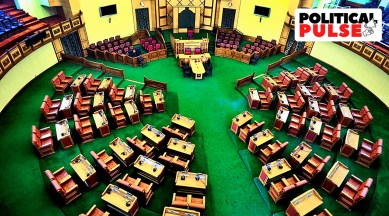11-minute Manipur session: On average, House sittings lasted 5 hours in 2022 across 20 states
PRS data shows average sitting days declined steadily in 24 state Assemblies from 2016 to 2022

The one-day Manipur Assembly session, the first since violence erupted in the state on May 3, lasted 11 minutes before it was adjourned amid protests. Soon after Speaker Thokchom Satyabrata took his seat, Congress Legislature Party (CLP) leader and former CM Okram Ibobi Singh protested against the nature of the session. “Is it (the session) emergency or short notice? We are confused. There is no rule of law in the land,” he said.
On summoning state legislatures, Article 174 of the Constitution states, “The Governor shall from time to time summon the House or each House of the Legislature of the State to meet at such time and place as he thinks fit, but six months shall not intervene between its last sitting in one session and the date appointed for its first sitting in the next session.”
monthly limit of free stories.
with an Express account.
If six months pass between two Assembly sessions, it is then assumed that the state Assembly has lapsed. The Constitution, however, does not state how long an Assembly session should last.
According to PRS Legislative Research’s Annual Review of State Laws 2022, average sitting days declined steadily in 24 state Assemblies from 2016 to 2022, with the decline in 2020 because of the Covid-19 pandemic. Sitting days declined the most in Telangana, Madhya Pradesh, and Goa, according to PRS. Haryana, Punjab, and Tripura had not met for more than 20 days in any year since 2016, it said. The 24 Assemblies met for an average of 25 days in this period. Kerala had the highest number of average sitting days at 48 days a year, followed by Odisha (41), and Karnataka (35).
The average duration of a sitting (across 20 states) was five hours in 2022. On average, a sitting in Maharashtra lasted eight hours while in Sikkim it lasted for two hours. “However, there could be significant variation in the duration of sittings in a state. For instance, in Chhattisgarh, while a sitting was seven hours long on average, one sitting (where a no-confidence motion was discussed) lasted longer than 13 hours,” said PRS.
Last year, 28 state Assemblies met for 21 days on average. Karnataka met for the highest number of days (45), followed by West Bengal (42), and Kerala (41). West Bengal and Maharashtra met for more days in 2022 as compared to 2021. In 2021, they met for 19 and 15 days respectively. States that met for fewer days in 2022 as compared to 2021 include Himachal Pradesh, Kerala, and Telangana. Seventeen states met for less than 20 days and of these three met for less than 10 days (Arunachal Pradesh, Nagaland, and Tripura). No data is available for Manipur.
“In most states, legislatures meet for two or three sessions in a year — a longer budget session, held between January and March, followed by brief Monsoon and Winter sessions. Twelve states, including five in the Northeast Region, met for only two sessions in 2022. In 2022, 61% of sittings were held during the budget session. Tamil Nadu held more than 90% of its sittings in the budget session. Gujarat and Rajasthan held more than 80% of their sittings in the budget session,” PRS said.
Earlier this year, the Budget session in Manipur commenced on February 2 and had 12 sittings.
According to the National Commission to Review the Working of the Constitution (NCRWC), states should set a target of minimum sitting days for their legislatures based on the number of members in the Assembly. States such as Karnataka, Rajasthan, and Uttar Pradesh have made it mandatory for their legislature to sit for a minimum number of days through the Rules of Procedure of their Assemblies or legislation. These limits vary from 35 days in Himachal Pradesh to 90 days in Uttar Pradesh. None of these states have fulfilled the target since 2016 (the year from which data has been collected for these states).